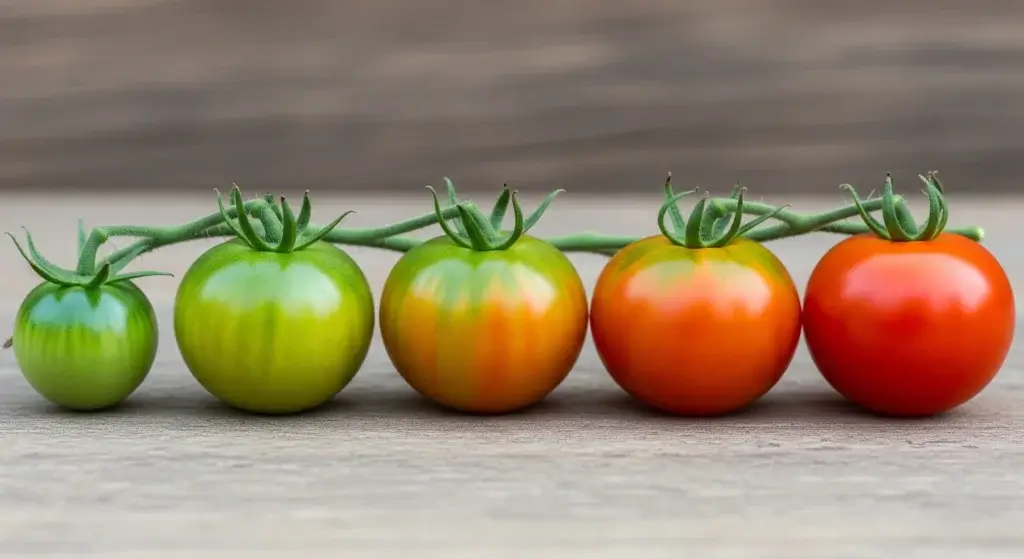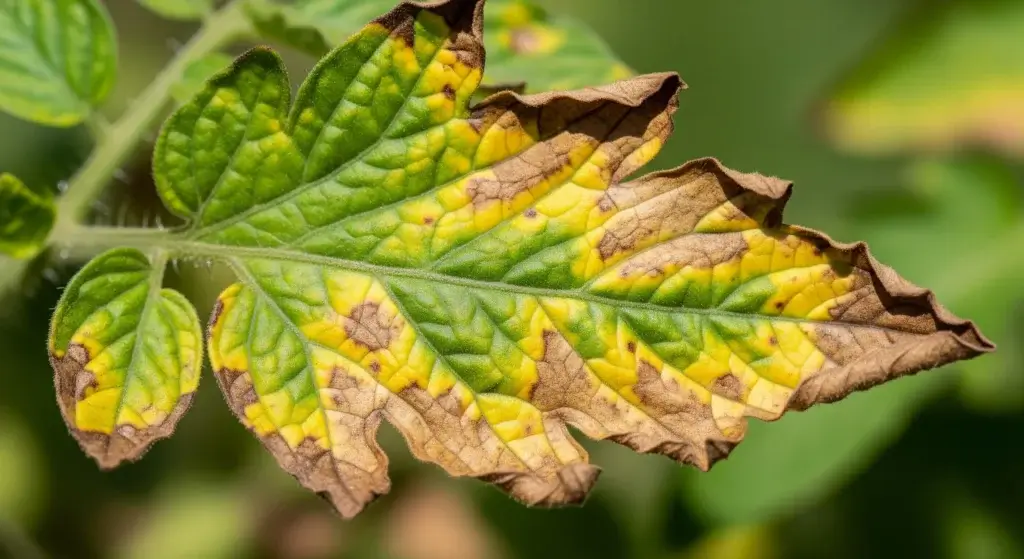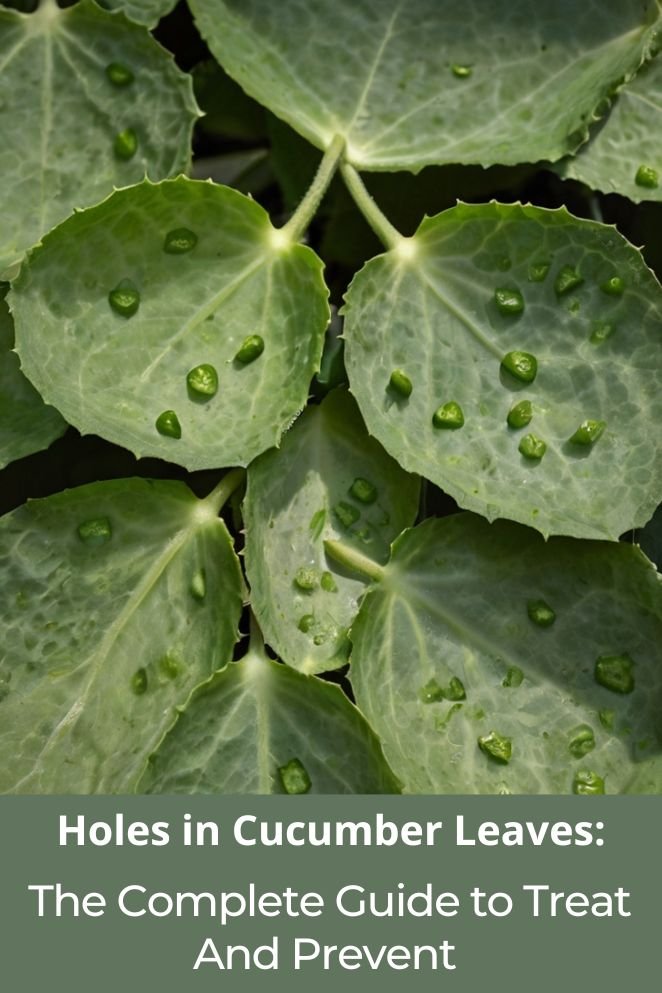
Got holes in your cucumber leaves? Total garden drama.
These mystery munchies aren’t just ugly—they’re a warning sign that pests are throwing a leafy rave at your plant’s expense.
This quick guide helps you ID the bad guys (looking at you, beetles and caterpillars), kick them out with smart treatments, and lock down your garden like it’s Fort PlantKnox.
Think of it as pest control meets Marvel origin story—your cukes are about to become superheroes.
Understanding Cucumber Leaf Damage: Why It Matters
Okay, real talk—those weird holes in your cucumber leaves? They’re not just cosmetic.
They’re like the Bat-Signal for bigger problems.
Tiny pests are sneaking in like ninjas, chewing up your plants, and leaving the door wide open for diseases.
And when your leaves can’t photosynthesize properly (aka plant food magic), your future cucumbers might end up sad, shriveled, or MIA.
Here’s the kicker: the size, shape, and style of the holes are like crime scene clues.
Different bugs leave different bite marks—kind of like insect fingerprints.
If you know what to look for, you can bust the right pest instead of spraying random stuff like you’re in a garden version of Whack-a-Mole.
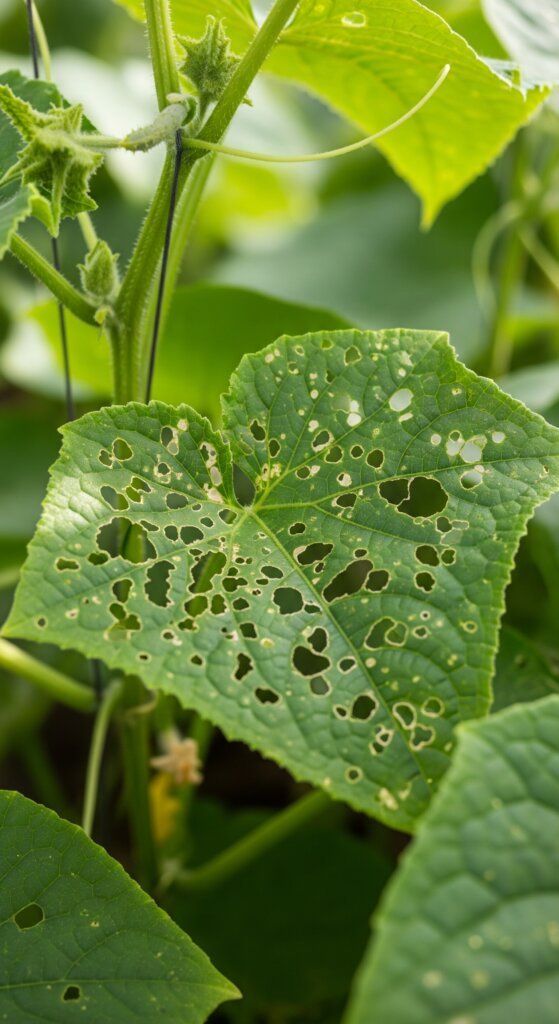
Primary Culprits Behind Holes in Cucumber Leaves
Your cucumber leaves didn’t just randomly get holes—they’ve got enemies.
Let’s unmask the main villains turning your garden into a salad buffet:
1. Striped cucumber beetles
Think of them as the Loki of garden pests—sneaky, destructive, and dramatic.
These yellow-green beetles with black racing stripes aren’t just chewing leaves and stems—they’re also spreading bacterial wilt like it’s gossip.
Identification signs:
- Weird little holes all over the leaves
- Chewed-up edges and wilting vibes
- Yellow beetles with black stripes (about the size of a sprinkle)
- Active during the day (no stealth mode here)
Damage patterns:
The adults munch leaves, while their larvae go underground and snack on roots—double trouble!
Think of them as the Thanos of your garden: snapping out your cucumbers one by one.
2. Flea beetles
These beetles are small but mighty, bouncing around like popcorn when you try to catch them.
They leave behind “shotholes” that make your leaves look like Swiss cheese.
Identification signs:
- Tiny round holes everywhere—like someone went wild with a hole punch
- Mostly wrecking young leaves and seedlings
- Dark, shiny bugs that jump like they’ve had too much coffee
- Love warm, dry days (they’re summer party pests)
Impact on plant health:
Seedlings don’t stand a chance when these guys attack, often getting stunted or even killed.
Older plants can usually shrug it off, but those holes still stress them out.
3. Spider mites
These microscopic suckers don’t chew; they suck.
They latch onto your leaves and suck out the juice, causing tiny speckled damage and sometimes webbing like your plants got a Halloween makeover.
Identification signs:
- Tiny speckles or pinprick holes on leaves
- Fine spider webs on leaf undersides (in serious infestations)
- Leaves turning yellow or bronze — not the good kind!
- You’ll need a magnifying glass to see these sneaky suckers
4. Slugs and snails
Think of these guys as the garden’s slow-moving monsters, sneaking around after dark and leaving big, smooth-edged holes that look like someone took bites out of the middle of your leaves.
Plus, they leave behind gross slime trails like unwanted autograph signatures.
Identification signs:
- Big, irregular holes with clean edges
- Shiny slime trails on leaves and soil — ew
- Damage usually smack dab in the leaf center
- They get extra active when it’s wet or after watering (they love a good rainy Netflix binge)
Identifying Your Pest Problem
Visual inspection techniques
If your cucumber leaves are looking like Swiss cheese, don’t just stand there—channel your inner plant Sherlock.
The first step to saving your crop is figuring out who exactly is throwing the garden party uninvited.
Step-by-step inspection process:
- Time it right: Check in the morning for night crawlers like slugs and snails. Do a midday stakeout to bust beetles and other daylight lurkers.
- Leaf check: Look at the size, shape, and location of holes. Is it a tiny nibble or a full-on salad bar situation?
- Flip it! Turn leaves over—eggs, larvae, and mini villains love hiding underneath.
- Dig a little: Check the soil and base of the plant. That’s where the undercover operators hang out.
- Track the damage: Take notes or snap pics with your phone (yes, you’re now the plant paparazzi) to see how fast things are going downhill.
- Check for side effects: Wilting? Discoloration? Stunted growth? These are like the aftershocks of a pest quake.
Distinguishing between pest types
Every pest leaves a calling card:
- Chewing insects (like beetles and caterpillars): Rough, jagged holes like they were going at it with tiny chainsaws.
- Raspers (slugs and snails): Smooth, round holes like someone took a tiny melon baller to your leaves.
- Suckers (spider mites, aphids): Tiny dots, speckles, or stippling. Less bite, more suck—like plant vampires.
Knowing who’s responsible means you can serve justice properly—no more guessing and wasting time on treatments that don’t work.
Because let’s be honest: spraying random stuff is so last season.
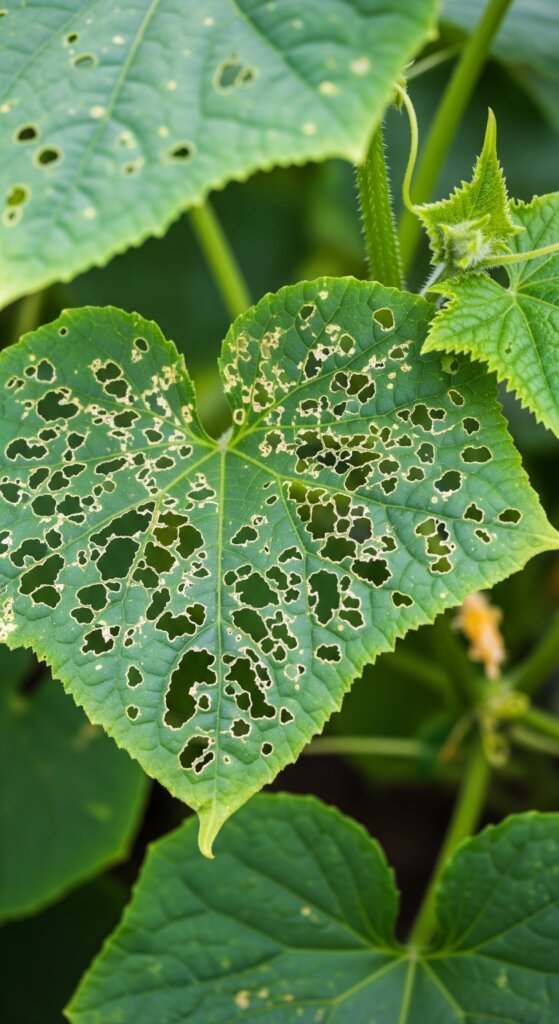
Effective Treatment Strategies
So you’ve spotted holes in your cucumber leaves? Don’t panic—but do move fast.
You’ve got 24–48 hours to stop this plant soap opera before it turns into a full-blown garden tragedy.
Immediate response actions
- Quarantine the patient: Move the chewed-up plants away from the healthy crew. We’re not letting this spread like a Netflix rom-com plot twist.
- Prune the crime scene: Snip off the worst-hit leaves. If it’s crawling with pests or looks like it went through a paper shredder—bye!
- Use targeted weapons: Match your treatment to the pest (no generic bug sprays like it’s a one-size-fits-all hat).
- Daily check-ins: Monitor like a hawk. Is the damage slowing down? Are pests ghosting your plants?
Organic Treatment Options
Beneficial insect
Ladybugs, lacewings, and braconid wasps aren’t just cute—they’re the Avengers of your garden.
Set up a bug-friendly hangout spot (think wildflowers + no harsh chemicals), and let them do the dirty work.
Homemade spray solutions
Mix up your own cucumber defense potion:
- 2 cups isopropyl alcohol
- 5 cups water
- 1 tablespoon liquid soap
Spray one leaf first to make sure your plant doesn’t freak out.
This mix messes with bug vibes and ruins their dinner plans.
Physical control methods
- Stick some yellow sticky traps around—bugs think it’s the sun and get stuck like fools.
- Shake plants and catch falling beetles with cardboard (or use a handheld vacuum like a gardening Ghostbuster).
- Pair this with sprays or traps for a tag-team takedown.
Cultural Control Practices
Row cover
Cover your cukes with light fabric right after planting. It’s like bug-proof armor.
Take it off when the flowers bloom so bees can do their thing, then re-cover if pests start plotting again.
Crop rotation
Don’t grow cucumbers in the same spot year after year.
That’s like sending pests an engraved invitation. Moving them messes up the bad guys’ life cycle.
Companion planting
Mix cucumbers with corn or broccoli. It confuses striped cucumber beetles and actually reduces the chances of your plants catching bacterial wilt.
Basically, it’s a pest-proof buddy system.
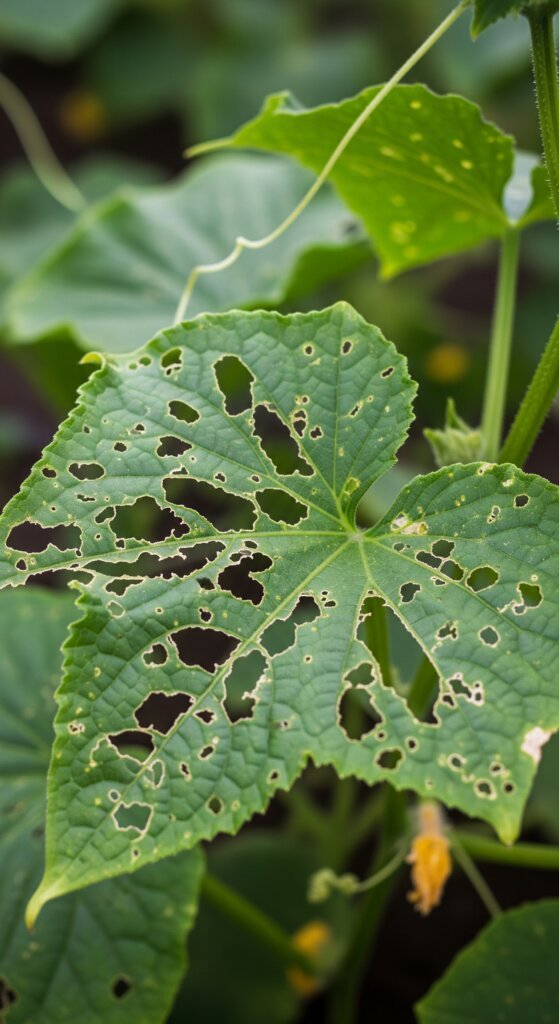
Prevention: Building Long-term Plant Health
Wanna stop bugs before they even think about munching on your cucumbers? It’s all about strong roots, clean spaces, and keeping a sharp eye.
Think of it like turning your garden into a health spa + military boot camp combo.
Soil health and plant nutrition
Strong plants don’t panic when pests roll up—they fight back. It all starts underground.
If your soil is healthy, your cucumbers will be tougher, happier, and basically unappetizing to freeloading insects.
How to level up your soil game:
- Compost like it’s a lifestyle: Add rich compost every year to boost organic matter. It’s like a smoothie for your soil.
- pH check, please: Cukes love slightly acidic vibes—aim for 6.0 to 6.8. Grab a test kit and play garden scientist.
- Moisture matters: Keep the soil evenly moist with mulch and regular watering. Dry soil = stressed plants = pest bait.
- Fertilize with purpose: Don’t just toss random stuff on your beds. Use balanced fertilizer based on a soil test (yes, that test again).
Garden hygiene practices
Bugs love mess. If your garden looks like a post-party scene, pests will move in and stay for the sequel.
Your garden clean-up checklist:
- After harvest? Clear the scene. Old cucumber plants are Airbnb for bugs. Pull them ASAP.
- Get your till on: Light tilling between seasons disrupts pest party plans in the soil.
- Weed patrol: Weeds = hiding spots. Keep the area around cucumbers clear.
- Tool TLC: Dirty tools spread diseases and eggs. Give them a good wipe-down before storing.
Monitoring and early detection
Early detection is EVERYTHING. Don’t wait for your leaves to look like Swiss cheese.
The earlier you spot a problem, the easier it is to shut it down.
Weekly check-in schedule:
- Early season: Check transplants daily—pests move in fast when plants are young and tender.
- Mid-season: Do a weekly pest patrol. Look under leaves, in the soil, and around stems.
- Late season: Watch for second-wave invaders. Some pests wait till your plants are tired to make their move.
Advanced Management Techniques
If you’re tired of playing whack-a-mole with every new bug that pops up in your garden, it’s time to level up with Integrated Pest Management (IPM)—aka the master strategy that combines all your best moves into one slick, pest-fighting plan.
Think of it like assembling the Avengers… but for cucumbers.
Integrated Pest Management (IPM)
Instead of relying on just one method (cough random spraying), IPM is about using a smart combo of tactics that knock out pests without wrecking your soil, scaring off the good bugs, or turning your garden into a chemical war zone.
Here’s how it breaks down:
1. Prevention
Start smart so bugs never get the invite. Use crop rotation, row covers, companion planting—the usual suspects.
It’s like locking your doors before trouble starts.
2. Monitoring
Be the nosy neighbor your garden needs.
Regularly check your plants like they’re celebrity gossip—who’s here, what damage are they doing, and how fast is it spreading?
3. Biological control
Let nature fight nature. Ladybugs, lacewings, parasitic wasps—these garden MVPs will take care of your pest problem faster than you can say “eco-friendly assassin.”
4. Mechanical control
Get hands-on. Trap ‘em, vacuum ‘em, or flick those beetles into a bucket like you’re playing Bug Bowling.
Row covers and sticky traps also count.
5. Chemical control
Use it only when you’ve tried everything else.
Go for targeted, low-impact treatments that won’t nuke your garden’s whole ecosystem.
Resistant Variety Selection
Why fight pests tooth and nail when you could just grow cucumbers that fight back?
Some varieties are basically pest-resistant superheroes—built to tolerate beetle bites and outrun disease like it’s the 100m sprint at the Garden Olympics.
Look for cukes that boast:
- Beetle bite tolerance (because they will try)
- Resistance to bacterial wilt (a real harvest-ruiner)
- Fast growth (so they bounce back before pests do real damage)
- Thick foliage that hides the leaves like a built-in pest repellent cloak
Pro tip: Check with your local extension office or garden center to see which varieties thrive in your zone. Because what works in California might flop in Kentucky.
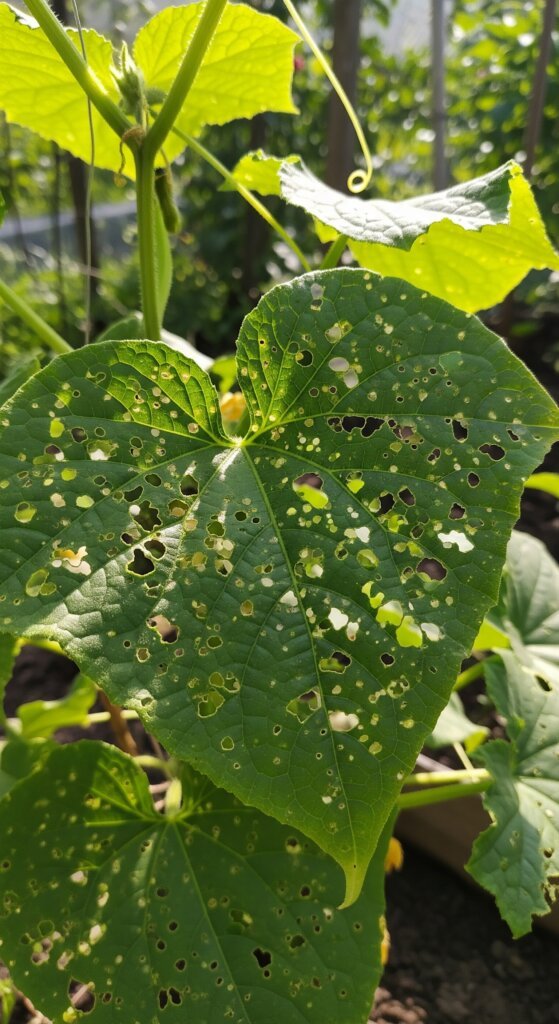
Troubleshooting Common Treatment Failures
So you sprayed, trapped, sprinkled, and still… your cucumber leaves look like they went through a paper shredder. Frustrating? Totally.
Why do treatments sometimes fail?
1. Wrong pest, wrong plan
You treated for beetles, but it was spider mites all along? Classic case of pest mistaken identity.
If you don’t know who the enemy is, your battle plan’s gonna fall flat.
2. Bad timing
Some pests have very specific stages where they’re vulnerable.
If you treated when they were hiding in eggs or playing it cool underground, your spray didn’t stand a chance.
3. Weak application
Spraying like you’re misting a houseplant? Nope. You need full coverage—tops, bottoms, stems, everywhere.
Otherwise, the bugs just laugh and keep snacking.
4. Stressed-out plants
Even the best treatment won’t help if your cukes are already hangry, thirsty, or trying to survive in terrible soil.
Healthy plants = better resistance and faster recovery.
5. No follow-through
Pest control is not a “one and done.” You’ve gotta monitor, reapply, and keep tabs like a clingy ex (but, you know, in a good way).
Adjusting management strategies
When your first move doesn’t work, it’s not a loss—it’s a clue. Here’s how to regroup:
Step 1: Double-check your pest
Pull out the magnifying glass and play garden detective again.
Confirm you’re actually treating the right villain. (Spider mites and flea beetles may leave similar drama but need totally different fixes.)
Step 2: Look at your timing
Was the pest in its sneaky stage when you treated? Adjust your timing to hit ‘em when they’re weakest.
Step 3: Check your technique
Were you spraying with enough oomph? Did you get both sides of the leaves?
Use enough product and make sure it hits where the pests actually hang out.
Step 4: Factor in the weather
Heavy rain, blazing heat, or high humidity can make even the best treatment flake out.
Keep an eye on the forecast before applying anything.
Step 5: Switch it up
If your one trick didn’t work, go full combo move. Add sticky traps, recruit beneficial bugs, change your spray—this is IPM, not a solo act.
Conclusion: Mastering Cucumber Leaf Health
Keeping your cucumber leaves hole-free isn’t rocket science—it’s more like gardening with a side of detective work.
Spot problems early, ID the pest like a pro, take action fast, and don’t forget the long game: prevention, strong soil, and consistent check-ins.
The real secret sauce? Stay observant, keep notes (yes, like a garden diary), and treat each season like a level-up.
The more you learn, the better you get at outsmarting those sneaky leaf-munchers.

